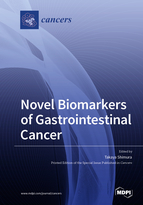Novel Biomarkers of Gastrointestinal Cancer
A special issue of Cancers (ISSN 2072-6694). This special issue belongs to the section "Cancer Biomarkers".
Deadline for manuscript submissions: closed (30 November 2021) | Viewed by 40129
Special Issue Editor
Interests: urinary biomarkers for gastrointestinal cancer; serum biomarkers for gastrointestinal cancer; liquid biopsy for gastrointestinal cancer; protein biomarkers; miRNA biomarkers; exosomal biomarkers; genetic biomarkers; tumor microenvironment; angiogenesis
Special Issue Information
Dear Colleagues,
Gastrointestinal (GI) cancer is a major cause of morbidity and mortality in the world. Since early diagnosis and optimal treatment selection are crucial to improve the prognosis of these diseases, the discovery of useful biomarkers has the potential to greatly reduce their burden. Recent technical and mechanical developments have enabled detecting tiny differences in various factors that are modified in physical condition, which might contribute to novel biomarker discovery for some diseases.
In this Special Issue, we focus on novel biomarkers for GI cancers, including esophageal cancer, gastric cancer, colorectal cancer, liver cancer, pancreatic cancer, biliary cancer, and small intestinal cancer. In addition, any samples (tissue, blood, urine, feces, saliva, gastric juice, bile, pancreatic juice, and so on) are welcome as biomarker sources, although body-fluid-based biomarkers are promising as diagnostic biomarkers due to their noninvasiveness. This Special Issue aims to collect novel insights to clarify the current situation and future perspective in this field.
Dr. Takaya Shimura
Guest Editor
Manuscript Submission Information
Manuscripts should be submitted online at www.mdpi.com by registering and logging in to this website. Once you are registered, click here to go to the submission form. Manuscripts can be submitted until the deadline. All submissions that pass pre-check are peer-reviewed. Accepted papers will be published continuously in the journal (as soon as accepted) and will be listed together on the special issue website. Research articles, review articles as well as short communications are invited. For planned papers, a title and short abstract (about 100 words) can be sent to the Editorial Office for announcement on this website.
Submitted manuscripts should not have been published previously, nor be under consideration for publication elsewhere (except conference proceedings papers). All manuscripts are thoroughly refereed through a single-blind peer-review process. A guide for authors and other relevant information for submission of manuscripts is available on the Instructions for Authors page. Cancers is an international peer-reviewed open access semimonthly journal published by MDPI.
Please visit the Instructions for Authors page before submitting a manuscript. The Article Processing Charge (APC) for publication in this open access journal is 2900 CHF (Swiss Francs). Submitted papers should be well formatted and use good English. Authors may use MDPI's English editing service prior to publication or during author revisions.
Keywords
- diagnostic biomarkers for gastrointestinal cancer
- prognostic biomarkers for gastrointestinal cancer
- biomarkers to help decision making for gastrointestinal cancer
- predictive biomarkers for therapeutic outcomes including efficacy and adverse events







